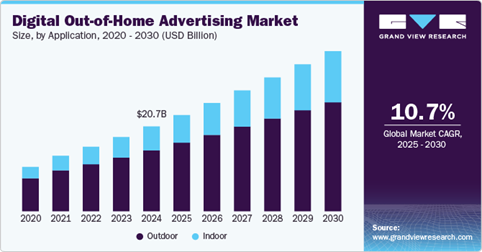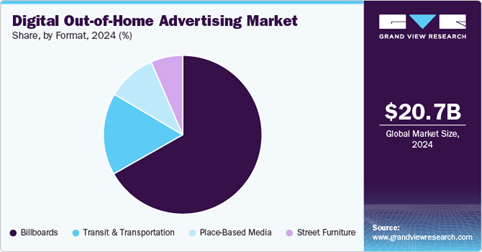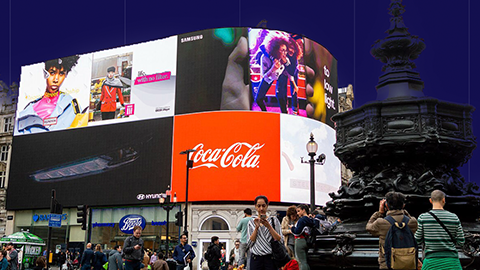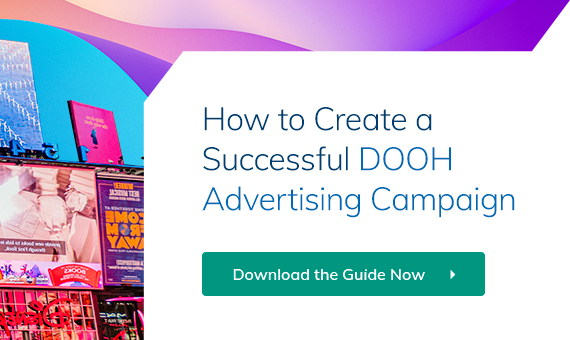DOOH Advertising: A Marketing Option That’s Gaining Ground
DOOH advertising is fast on the rise.
According to Grandview Research, the size of the global digital out-of-home advertising market was estimated at US $20.74 billion in 2024 and is expected to reach US $23.52 billion in 2025.
Over the next five years, these figures are only set to skyrocket. Indeed, growing at compound annual growth rate (CAGR) of 10.7% between 2025 and 2030, Grandview anticipates the global DOOH advertising market to reach a whopping $39.12 billion by the end of the forecast period.

(Image source: Grandview Research)
Key factors driving growth in the DOOH advertising market include the increasing demand for creative and interactive displays of full-motion video on digital display boards in public places, and the inclusion of animation. Moreover, according to the report, digital outdoor advertising is gaining popularity as it allows brands to reach mass audiences consistently and rapidly, complements brands’ advertising campaigns on other channels, and is becoming increasingly cost-effective as its usage increases across the globe.
Demand for billboard technology commands the biggest market share, followed by Transit & Transportation advertising, and Place-Based Media.

(Image source: Grandview Research)
Clearly, DOOH advertising is becoming a marketing powerhouse that’s quickly gaining ground.
Here’s how you can reap the rewards of DOOH advertising for your brand.
What Is DOOH Advertising?
As its name suggests, digital out-of-home or DOOH advertising is an electronically enhanced version of out-of-home (OOH) advertising – which typically consists of physical display installations in public spaces, such as on billboards, at transit stations or on street furniture, to name but a few. Brands can use OOH advertising to expand their reach into major town and city centers and along transit routes, where potential customers can be exposed to promotional messaging through the course of their daily lives.
With digital out-of-home advertising, however, brands enjoy the increased benefits of adaptability, interactivity, and – crucially – up-to-the-minute analytics into advertising performance.
DOOH advertising combines hardware and software technologies that allow brands to advertise their goods and services on digital screens to deliver targeted ads in areas that large numbers of potential buyers populate or pass through. Advertisers can even update their messaging in real-time in response to dynamic conditions like the weather, or in accordance with target audience demographics.
Marketers can also configure DOOH advertising installations to collect customer data, measure viewer sentiment about their brand, and to assist in generating leads.
Benefits of Integrating DOOH Advertising into Your Clients’ Marketing Mix
In an omnichannel commercial environment where buyers research, identify, and purchase products and services in both online and offline venues, individual marketing options cannot be used in isolation if brands are to fully gain from all the promotional avenues available. There are in fact several benefits to be had from incorporating DOOH advertising into a broader client marketing strategy. These include the following:
A Flexible and Cost-Effective Advertising Medium
Marketers can rotate the digital displays used in DOOH advertising within the physical confines of a single space or banner. This a cost-effective approach that optimizes revenue for the owner of the media unit, while enabling marketers to share media costs with multiple advertisers and save on printing costs.
Digital display media also offer the ability to change dynamically based on triggers – such as time of day or day of week, seasonal variations, weather conditions, and demographic data – which gives advertisers enormous flexibility and scope for targeting and personalization.
Greater Audience Engagement
By using video, animation, and newer formats such as Augmented Reality and holograms, advertisers can create imaginative digital displays that tell an engaging story to would-be consumers. Coupled with data relevant to target audiences, engaging DOOH advertising also offers marketers opportunities for location-based ads and prompts that encourage impulse buying.
Interactive Advertising
Employing interactive elements like touch screens, QR codes, and motion sensors, DOOH advertising can draw audiences into interactive and multi-channel experiences. For instance, QR codes can direct viewers to product or service landing pages to claim special offers, or to marketplaces where they can download apps or other resources.
Connecting Real World to Online
With DOOH advertising infrastructure that’s connected to the web, brands can move DOOH data to the cloud. If, for example, an ad kiosk also serves as a public Wi-Fi hotspot, marketers can track the number of devices connected to each kiosk – thereby giving an indication of the number of people viewing the ad.
Since consumer information is also stored in the cloud, connecting DOOH to customer data platforms also allows advertisers to target DOOH viewers once they go back online.
Best Practices for Integrating DOOH Advertising into the Broader Marketing Mix
For agencies looking to incorporate DOOH into their clients’ marketing mix, the key is to ensure seamless integration with existing digital and traditional advertising efforts. Here are some practical strategies to maximize effectiveness:
1. Align DOOH Advertising with Social Media & Digital Campaigns
DOOH advertising should complement rather than compete with a brand’s digital efforts. For example, if a brand is running a social media campaign around a product launch, DOOH screens can display real-time user-generated content from Instagram or TikTok to build engagement. Digital billboards can also feature QR codes that direct viewers to exclusive online promotions or other social content.
For example, a beauty brand launching a new skincare line could use DOOH screens in shopping malls to display live social media reviews and influencer testimonials, prompting customers to scan a QR code to redeem an in-store discount.
2. Use Data for Targeting & Personalization
One of DOOH’s greatest strengths is its ability to leverage real-time data for audience targeting. Brands can integrate first- and third-party data to ensure ads are shown to the right audience at the right time. Dynamic ad serving allows content to change based on factors such as time of day, weather, or even local events.
As an example, a sportswear brand could use DOOH to display different ads depending on the temperature – promoting, for instance, running gear in the morning and rainproof jackets when storms are forecast.
3. Bridge the Gap Between Physical & Digital Shopping
DOOH can act as a powerful tool for driving online traffic and ecommerce sales. By featuring interactive elements like touchscreens, NFC (near-field communication), or mobile app integrations, brands can create a seamless path from physical to digital engagement.
For example, a luxury fashion brand could install interactive digital screens at transit hubs where commuters can browse collections and purchase items directly via a linked mobile app.
4. Integrate DOOH into Programmatic & Omnichannel Strategies
DOOH should be part of a brand’s broader ad-buying strategy. Agencies can sync DOOH campaigns with online display and search ads to create a unified customer journey. If a user has been exposed to an online ad, DOOH can reinforce the message when they are near a store, increasing the likelihood of conversion.
In the wild, this could be something like a travel company running an online campaign for last-minute vacations, and then retargeting potential customers by serving tailored DOOH ads at airports, showing exclusive offers just before they book their next trip.
5. Ensure Omnichannel Cohesion
To make DOOH a fully integrated part of the marketing mix, messaging must remain consistent across all channels. Creative assets, brand colors, and messaging should align with the brand’s online presence and other advertising efforts to maintain a seamless customer experience.
For example, a food delivery service promoting a new seasonal menu could synchronize DOOH ads in high-traffic areas with app notifications, social media posts, and paid search ads, ensuring the same promotional message reaches consumers across multiple touchpoints.
Final Recommendations
Your DOOH advertising integration efforts can only be enacted by teaming with the right technical partner.
Specializing in programmatic DOOH advertising (pDOOH), The Neuron offers a unique bidding technology that utilizes a smarter, more dynamic algorithm to deliver higher-impact ad placements at lower costs for clients. Users can automatically activate campaigns based on user actions, time, weather, inventory changes, or trends for timely, relevant ads.
To learn more about DOOH advertising integration with The Neuron, visit our website.


